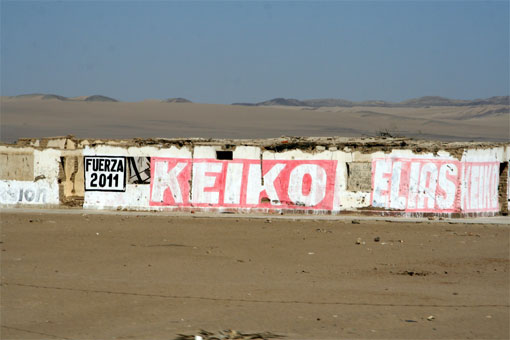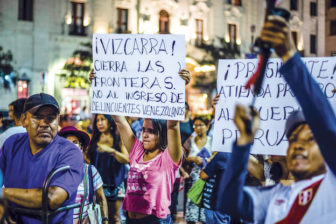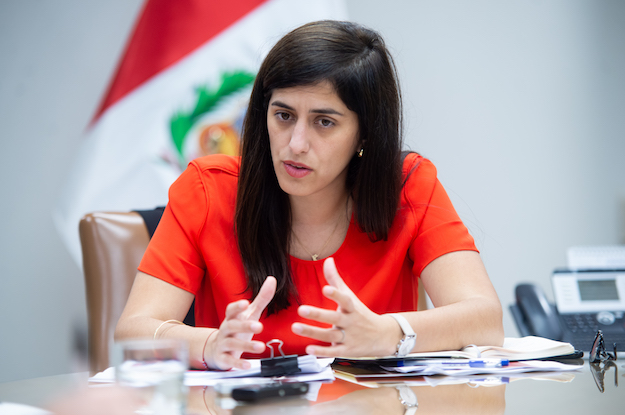Peruvians are bracing themselves for one of the most divisive presidential campaigns in recent history, with nationalist Ollanta Humala set to face off against right-wing Keiko Fujimori on June 5.
The former colonel, who once led a coup against the corrupt administration of Ms. Fujimori’s father Alberto, has garnered 31 percent of the vote with 85 percent counted.
Ms. Fujimori has about 23 percent of the vote.
Both candidates appeal to the 35 percent of Peruvians who still live in poverty, and their success in the first round is a testament to the deep vein of dissatisfaction that runs through lower socioeconomic sectors who feel shut out of Peru’s “economic miracle.”
After a decade of China-like rates of economic growth, a 14 percentage point drop in poverty levels and avid courtship of foreign investment and free trade deals, Peru now has one of the fastest-growing economies in the world.
Mr. Humala has repeatedly driven this message home in campaign rallies across the country, asking voters, “Have you had a 10 percent increase in your household budget recently?” (Peru’s gross domestic product is forecast at 7 percent for 2011, but January growth figures hit 10 percent.)
Mr. Humala has also sought to model himself after the moderate left of Luiz Inácio Lula da Silva of Brazil rather than his former close ally Hugo Chávez. Mr. Chávez called Mr. Humala “a good soldier” recently and Bolivia’s radical leftist president Evo Morales also gave a “fraternal and revolutionary salute” to the Peruvian candidate.
An overcrowded field of center to center-right candidates also contributed to the rise of both Mr. Humala and Ms. Fujimori, splitting the base of voters who favor preserving the current economic model.
Pedro Pablo Kuczynski (PPK), the former finance minister and Wall Street banker, came closest to edging Ms. Fujimori out for a final run at the presidency. Alejandro Toledo lost what had at one time seemed an unbeatable lead amid character attacks against his opponents, and Luis Castañeda, former mayor of Lima, grew quieter as the campaign wore on.
Combined, their votes add up to around 47 percent of the Peruvian electorate.
As Peru’s Nobel laureate Mario Vargas Llosa has summed up so eloquently, Peruvians are now faced with a polarizing, paralyzing decision: “terminal cancer or AIDS.”
The writer, who lost a presidential election to Alberto Fujimori in 1990, also says Messiers Kuczynski, Toledo and Castañeda managed to “shatter” a chance for stability, economic progress and democracy.
Mr. Humala narrowly lost the 2006 election to Alan García, a man many Peruvians thought they would never vote for again after his disastrous first term presiding over hyperinflation and descent into civil war against the bloody leftist Shining Path and Túpac Amaru insurgencies.
Like Mr. García, Mr. Humala must also convince Peruvians that he is a “new man”.
His road to Damascus was a lot shorter than Mr. García’s—it is only five years ago that he was touting the nationalization of key sectors and the rejection of a United States trade deal.
With the help of Brazilian advisers, he has conducted a disciplined campaign that has stuck to key messages aimed at the young and dispossessed, including old-age pensions for workers from the vast informal sector, an increase in the minimum wage and increased citizen security.
The gap between his more moderate record and his written plan of government is big at times; on Sunday Mr. Humala acknowledged this, saying he would be willing to compromise significantly to secure a win.
However, Mr. Vargas Llosa sums up the fears many have of going the way of Venezuela or Nicaragua when he says he doubts Mr. Humala’s claim to being a “disciple of Lula.”
Mr. Humala has grown among middle-class voters and has polled strongly across the country. He won in 18 of Peru’s 24 regions, from the jungle to the coast and the sierra. He also came in second to PPK in Lima.
Voters also selected a new 130-member Congress. Humala’s party, Gana Perú, will have the largest block, with a projected 46 lawmakers, followed by Fujimori’s Fuerza 2011 with 38, Toledo’s Perú Posible with 21, PPK’s coalition—Alianza por el Gran Cambio—with 12, and Castañeda’s Solidaridad Nacional with nine.
The ruling Alianza Popular Revolucionaria Americana (APRA) party, which did not run a candidate after Mercedes Aráoz, an independent who identified as an “Alanista,” pulled out of the race, will be a shadow of its former self with four to six seats.
Erasto Almeido, of New York-based Eurasia Group, says Mr. Humala is also the candidate most likely to satisfy a thirst for change.
“We have long been arguing a desire for change would be a key driver of this election and that most observers have been underestimating Humala’s chances,” Mr. Almeido wrote in a research note. He continued: “…This time around Humala will probably be even more competitive given that he has moderated his discourse in comparison to the 2006 election and, more importantly, Fujimori will struggle to appeal to such a wide constituency, as García did in 2006.”
While Mr. Humala has proven capable of increasing his share of the vote, Ms. Fujimori has maintained a solid level of support. She is likely to secure the backing of Peru’s business community and elites, and could work out endorsement deals with PPK or Mr. Castañeda.
But being cast as the candidate of the elite could prove awkward for her, as her strongest appeal—aside from die-hard Fujimoristas who support her jailed father—is among Peru’s poorest.
She has also promised direct assistance programs for Peru’s poorest citizens, improved education, technical colleges for regions and better remuneration for teachers. But she must counter suspicions that her presidency would be no more for a front for her father, who is serving 25 years for human rights offences and corruption—an impression strengthened by her promise early in the campaign to release her father from prison if elected.
Ms. Fujimori has striven to highlight her father’s successes in economic reform and quashing terrorism—and brushed away criticisms of the Fujimori administration.
Both candidates are vulnerable in their way to character attacks and questions about their dubious family members. Mr. Humala’s brother Antauro is in jail for a failed revolt against Mr. Toledo in 2005, and he himself has faced accusations—now withdrawn—of torturing villagers in Madre Mia while in the army.
Ms. Fujimori has been questioned repeatedly over the opaque sources of financing for her studies in the U.S., and, some say, her presidential campaign. She has also drawn criticism for her poor record of attendance as a congresswoman. And there is, of course, her father, who dissolved Congress in a 1992 auto-coup, and later fled the country.
Again, Mr. Vargas Llosa is succinct in summarizing the fears of anti-Fujimoristas, saying a Keiko presidency would mean “the criminals would go directly from prison to the government.”
It will be a tight race—and, most likely, a dirty one.








